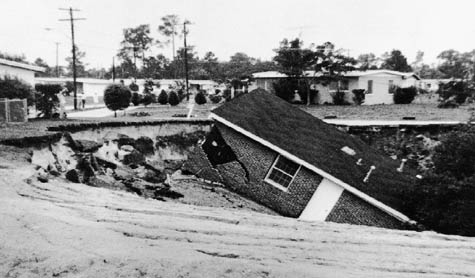 [Image: An otherwise unrelated photograph of a house radically subsiding; courtesy of NOAA].
[Image: An otherwise unrelated photograph of a house radically subsiding; courtesy of NOAA]."The cavern was formed over three decades," the AP writes, "as oil field service companies pumped fresh water into a salt layer more than 400 feet below the surface and extracted several million barrels of brine to help with drilling... Over the past few decades, communities in Texas, Kansas, Michigan, Canada and Europe learned of similar underground danger only after cracks appeared and the ground began to sink." Unsurprisingly, then, "this man-made salt cavern has residents nervous."
It's interesting to point out, however, that Carlsbad, NM, is, of course, home to Carlsbad Caverns—making this delirious salt cave a kind of upstart simulacrum, a replicant geology intent on asserting its prominence over the natural formations nearby. We will be assaulted by copies from below.
But I mention this here because of the idea that Carlsbad could easily become the setting of some future variant of Sigizmund Krzhizhanovsky's story "Quadraturin," mentioned previously, in which the fabled room-expanding substance is accidentally deployed underground, deep-injected in an act of misguided chemical sequestration, only to form vast and endlessly self-expanding caverns miles below the earth's surface.
Unpredictably fractal and resistant to all known forms of cartography—perhaps it could even be a Mandelbulb—these weirdly life-like systems of space coil and surge through bedrock, threatening to destroy all those who live above. Living space, crawling through geology.
(Thanks to Steve Silberman for the tip!)
No comments:
Post a Comment